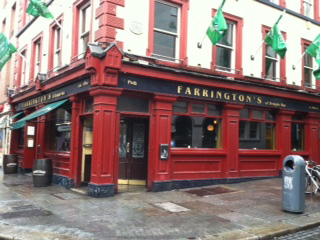 |
| Cycling the wild and windy moors of south Ireland |
A meeting with my cycle mates began in New York City. There was Andy, our guide, an Irishman from Belfast, with a mop of red hair, a ready smile, and legs short and sturdy for pedaling a bike or walking a mountain. He had a knowledge of primus stoves, flat tires, and a tendency to worry about what the Irish Youth Hostel Association would think of these “crazy Americans.” The rest of the group included three other women--Ruth, Jan, and Dottie, plus three men--Larry, Allen, and Frank. We departed New York on the USS Washington, a converted troop ship on its last run. Andy told us, “There are 180 steps around the ship deck, 280 around the promenade deck, so get in shape!”
We arrived in Cobh, on the southern-most tip of Ireland, a quaint storybook town of pink, yellow, blue, and orange houses, flush with the walk that faced the harbor. Once through customs we had to equalize our thirty pounds of essentials in the saddle bags across our back wheels. My essentials included one dress and three pairs of pants (one to wear, one to wash, one to dry.) Add to this, lipstick for city sightseeing, one poncho for rainy days, and one sleeping sack (a sheet sewed on three sides.) I also carried a small pouch on my belt for my passport, AYH ID card, and spare money. We were expected to live in a budget of $1.50 a day! In 1950 that included a fee for the hostel and groceries to cook our own meals.
An unbalanced bike can buck like a bronco and it proved to be a hysterical scene, that first day in Cobh. I had repacked and was ready to mount my “steed” only to find that the front wheel reared up in a most disrespectful way, throwing me to the ground. I finally got the knack of throwing my weight forward as a counter balance to the weight of the gear placed at the rear wheel.
Leaving Cobh, we struggled up a long hill. At the top we could look back to the sea and the harbor where we had left the USS Washington. We were wanderers in a strange land. The incline of the hill soon forced us to dismount and continue upward walking our bikes, or “bushin” as the Irish say. On and on we rode, past brilliant fuschia hedges, quaint white-washed stone cottages–on towards Roches Point, our hostel for the night.
It was here that Andy gave us a choice: to ride the ten miles to Roches Point or to take a ferry across the inlet. The ferry, of course! We hurried on, passing a small village where shepherds drove their sheep to one side as we “roared” past. To our amazement we found the “ferry” was nothing more than a rowboat in which we must stand up with our bikes. Two crossings were necessary before we all reached the opposite shore.
The sight of our first hostel from a hilltop spurred us on. Roches Point, the lighthouse seen earlier from our ship, is a mainly a Coast Guard station. The hostel was located in an old barrack, without electricity or running water. So, like Jack and Jill, we went over the hill to get our pail of water. Roches light turned continuously all night long and although it intermittently hit me squarely in the eyes, I slept until the roosters were crowing. We left Roches Point the next morning, looking forward to our visit to Blarney Castle. There is an Irish saying that whoever kisses the Blarney Stone will either go to Parliament, or sleep in a lady’s bed. Says, Frank, “Who wants to go to Parliament?”
This is just the beginning of Aunt Carolyn’s chronicle of her first summer abroad. The trip to Ireland had many more adventures (which I will post at a later time) and inspired a lifetime of travel.
Note: In addition to sharing a love of travel and the similarity of our names, Carolyn T. Arnold and I both graduated from Grinnell College in Iowa (although nearly 40 years apart.) Many members of the Arnold family went to Grinnell, including my husband Art. In 1980, Aunt Carolyn was asked by one of his cousins to name her top favorite sights during her many years of travel. After listing famous places such as the Great Wall of China and seeing the midnight sun over a fiord in Norway, she concluded with this memory of her first trip to Ireland:
"It has been fun remembering. I might add one other sight for a personal reason as there is nothing remarkable about it except that it was my first view of a foreign land: sailing into the harbor at Cobh, Ireland. The clear green water of the harbor and the pink and green buildings facing us will always remain in my memory."


























